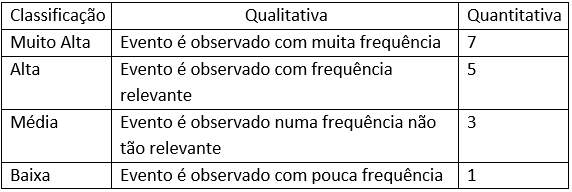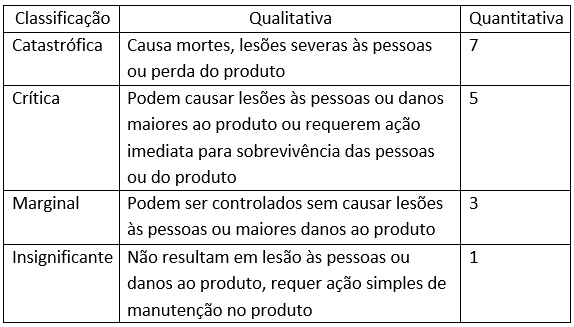[:pb]O que é análise de risco?
A grande maioria das normas internacionais se baseia no conceito de risco. Assim, é bastante interessante que o fabricante conduza uma análise de risco em diferentes momentos do projeto e da produção, de forma a identificar os principais ofensores, pontos fracos e de risco à segurança, e saiba como elaborar um documento que gerencie e classifique estes riscos, estabelecendo a forma mais factual e econômica de implementar ações para mitigar estes riscos.
Um risco pode ser traduzido como a ação conjunta da frequência de ocorrência com o efeito causado. A análise de risco pode ser quantitativa ou qualitativa.
Matematicamente, pode se dizer que o risco é o nível de sua ocorrência vezes o nível de sua severidade, ou seja;
R = O x S
Onde:
R é o risco quantificado,
O é a frequência com que ocorre, e
S é a sua severidade
A título de exemplo, pode-se classificar a frequência de ocorrência com uma descrição qualitativa e uma quantitativa:

Do mesmo modo, pode-se classificar, a título de exemplo, a severidade da ocorrência:

Numa visão gráfica pode-se verificar que o maior risco se situa no quadrante superior direito:

Nos exemplos acima, verifica-se que o maior risco é quantificado como 49, sendo classificado com uma muito alta frequência de ocorrência e uma severidade catastrófica.
Ou seja, quanto maior o produto entre a frequência de ocorrência e a severidade, maior será o risco.[:en]The vast majority of international standards are based on the concept of risk. Thus, it is pretty interesting for the manufacturer to conduct a risk analysis at different times of design and production to identify the main offenders, weaknesses, and security risks and know how to prepare a document that manages and classifies these risks, establishing the most tangible and cost-effective way to implement actions to mitigate them.
A risk can be translated as the joint action of the frequency of occurrence with the effect caused. Risk analysis can be quantitative or qualitative.
Mathematically, it can be said that the risk is the level of its occurrence multiplied by the level of its severity, that is,
R = O x S
Where:
R is the quantified risk,
O is the frequency with which it occurs, and
S is its severity
As an example, the frequency of occurrence can be classified with a qualitative and a quantitative description:

Likewise, one can classify, for example, the severity of the occurrence:

In a graphic view, it can be seen that the most significant risk is located in the upper right quadrant:

In the examples above, the highest risk is quantified as 49, classified with a very high frequency of occurrence and catastrophic severity.
That is, the greater the product between frequency of occurrence and severity, the greater the risk.[:]
